
10 Questions Students Can Ask to Make Their Schools More Caring and Safe Places
For Middle and High School Students - handout
- Subject:
- Other
- Material Type:
- Student Guide
- Provider:
- The BULLY Project
- Date Added:
- 11/14/2022

10 Questions Students Can Ask to Make Their Schools More Caring and Safe Places
For Middle and High School Students - handout

Understand what bullying is, how to help a peer or yourself. Understand some of the consequences that come with bullying.
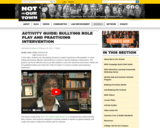
In this video, students use role-playing scenarios to depict experiences with prejudice or name-calling and practice effective interventions to combat or stop the bullying or harassment. This process can be an effective tool to use with students in your own classroom and school. Please use the guidelines below and review the “Note of Caution” to ensure a positive and productive experience.
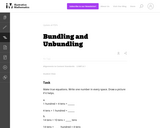
In this task students determine the number of hundreds, tens and ones that are necessary to write equations when some digits are provided. Students must, in some cases, decompose hundreds to tens and tens to ones.
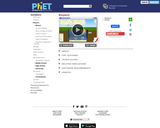
When will objects float and when will they sink? Learn how buoyancy works with blocks. Arrows show the applied forces, and you can modify the properties of the blocks and the fluid.
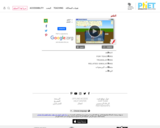
When will objects float and when will they sink? Learn how buoyancy works with blocks. Arrows show the applied forces, and you can modify the properties of the blocks and the fluid.

As an assistant attorney general in the Civil Rights Division of the Department of Justice, Burke Marshall played a key role in the federal government's efforts to desegregate the South. Representing the presidential administrations of John F. Kennedy and Lyndon B. Johnson, Marshall mediated conflicts between civil rights protesters and southern white officials. In this interview, Marshall recalls the 1961 Freedom Rides and the 1962 desegregation of the University of Mississippi.

In this episode, Matt and Dani talk with two groups of teachers about their experiences with burnout. They first talk with teachers from Ben Lomond High School in Ogden and then discuss the same topics with educators from the rural Piute School District. Listen to hear how burnout affects the educators in similar ways and how they are combatting it.
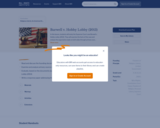
In this lesson, students will study the Supreme Court case Burwell v. Hobby Lobby (2013). They will examine the facts of the case and analyze the arguments made on both sides through primary source documents and preceding cases. They will then assess the majority and minority decisions for the case.
This is a 14-page Word document that contains information to teach about differences in culture that affect communication.Spend a day or two on this topic or a week or more depending on what you want to do.
Student learn how to follow written and verbal instructions
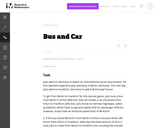
This task operates at two levels. In part it is a simple exploration of the relationship between speed, distance, and time. Part (c) requires understanding of the idea of average speed, and gives an opportunity to address the common confusion between average speed and the average of the speeds for the two segments of the trip. At a higher level, the task addresses N-Q.3, since realistically neither the car nor the bus is going to travel at exactly the same speed from beginning to end of each segment; there is time traveling through traffic in cities, and even on the autobahn the speed is not constant. Thus students must make judgements about the level of accuracy with which to report the result.
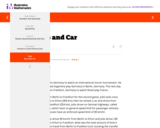
This Illustrative Mathematics task operates at two levels. In part it is a simple exploration of the relationship between speed, distance, and time. Part (c) requires understanding of the idea of average speed, and gives an opportunity to address the common confusion between average speed and the average of the speeds for the two segments of the trip.

Case background and primary sources concerning the Supreme Court case of Bush v. Gore. Dealing with the 2000 election, this lesson asks students whether or not they think the United States Supreme Court correctly decided the case.
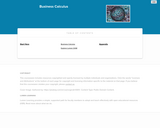
This course provides an introduction to applied concepts in Calculus that are relevant to the managerial, life, and social sciences. Students should have a firm grasp of the concept of functions to succeed in this course. Topics covered include derivatives of basic functions and how they can be used to optimize quantities such as profit and revenues, as well as integrals of basic functions and how they can be used to describe the total change in a quantity over time.

MATH&148 is a calculus course for business students. It is designed for students who want a brief course in calculus. Topics include differential and integral calculus of elementary functions. Problems emphasize business and social science applications. Translating words into mathematics and solving word problems are emphasized over algebra. Applications are mainly business oriented (e.g. cost, revenue, and profit). Mathematical theory and complex algebraic manipulations are not mainstays of this course, which is designed to be less rigorous than the calculus sequence for scientists and engineers. Topics are presented according to the rule of four: geometrically, numerically, analytically, and verbally. That is, symbolic manipulation must be balanced with graphical interpretation, numerical examples, and writing. Trigonometry is not part of the course.
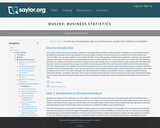
Introductory survey of quantitative methods (QM), or the application of statistics in the workplace. Examines techniques for gathering, analyzing, and interpreting data in any number of fieldsĺÎĺ from anthropology to hedge fund management.

Offers great information on developing and delivering business messages. This text also provides information on nonverbal communication and offers helps for ELL students/communicators.

This video excerpt from NOVA’s Making Stuff: Cleaner and accompanying demonstration introduce students to the production and importance of bioplastics, or plastics made from plant or animal products.
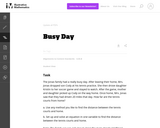
This task provides a good entry point for students into representing quantities in contexts with variables and expressions and building equations that reflect the relationships presented in the context.